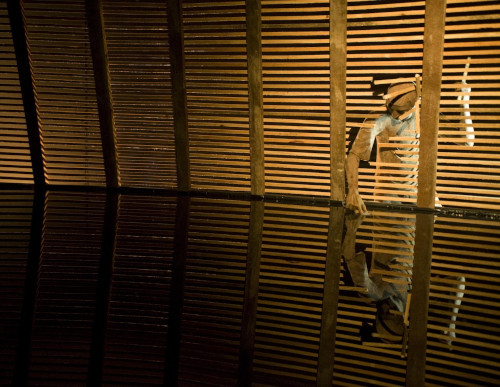
The remarkable stories of the jewels of Bragança house in the nineteenth century was the theme for a lecture by researcher Eduardo Alves Marques, author of "if the jewels could talk," within the conversations of "dar a ver", which addressed many of the caricatured and curious episodes of the various pieces of jewelery of Portuguese queens.
Where are the jewels of Portuguese queens today? Our story begins in 1834 when D. Maria II is acclaimed queen of Portugal, which is follow by D.Estefânia, Maria Pia of Savoy and D.Amelia in the twentieth century. But we also address the Empress D.Amelia of Leuchtenberg and the Countess d'Ebla that marries in second nuptials with the King D. Fernando II.
To understand the remarkable story of the crown jewels we have to make two distinctions, on one hand there are the so called jewels of the state, where the monarchy centered a series of specific rituals that count as a representation of power. Since 1640 the dynasty of Braganza offered the crown of Portugal to Our Lady of Conception is for this reason that there is no the coronation ceremony, but ovation. The State jewelery pieces are made with precious stones, silver and gold and can never be alienated, the king and queen could use them, transform them, but they can never be sold. Currently, the jewels are labeled, sealed and discriminated individually and safely kept at the Bank of Portugal.
Particular jewels are acquisitions made by the royal house through the state budget and we have to fit them into a constitutional monarchy. In this case, most of these private jewelery pieces are missing, they are returned to their rightful owners.


D. Maria II is the daughter of D. Pedro I Emperor of Brazil. In 700 years of history it is the first sovereign that travels and this allows hers to acquire knowledge that no king ever had to date. Between 1834 and 1853 is the culmination of Romanticism, less than 100 years the ruins of Pompeii were discover and there is a great interest in the former, they seek inspiration in the spirituality, what we once were and many of the Queen's jewels are inspired in this period. There is an emotional side in this very striking pieces, where it appears the representation of children, nephews, brothers and it is in this context that the miniatures appear, the bracelets are an ex-libris.

The Queen has 183 pieces of personal jewelry, one of the featured pieces is pendant and a necklace from ther mother's, D. Maria Leopoldina and a tiara with diamonds of various colors stones. A châtelaine with a pocket watch, from “Leitão and irmãos”, are also listed in the inventory.
D. Maria II establishes as one of the basic rules of her reign, end the law of primogeniture, which was that only the first-born is to inherit and the remaining seed had to make good marriages. From her reign each child shall receive exactly the same as the others, except the king who had his royal occupation. When the sovereign dies her private jewels are allotted by groups that are placed on a table. All lots are numbered and each of the seven surviving children choose a number at random.

King D. Fernando II came to the throne on the death of D. Maria II, as the infante is too young to reign. The widower sovereign in one of his trips to the theater ends up falling in love with an opera singer, Elise Hensler, a cultured and charming woman, with a small problem, did not belong to the nobility. Even so, against all odds he marry her, it is was a national scandal at the time, considering that he was in charge of the royal minor children. One of the most iconic jewelry that King offers her, on their wedding day, is a marigolds pin in gold the size of a hand. Each jewel carries a story, we can know the carat or the number of diamonds, but each of these pieces is an adventure and this concerns the great-granddaughter of the Countess who inherits a property that is the chalet wall, summer home of the Countess d ' Elda and the famous pin. This report begins with the granddaughter of the Countess who was a very elegant woman, who only bought the best brands and had so many Dior shoes that tied silk ribbons in the box to know what the respective color of the pair. Due to a fatality, she ends up dying in an car accident and the pin disappears. When the great-granddaughter of the Countess d'Elda come from the US and returns for good to Portugal in 1998, she decides to sell the house, because it had a great offer from a real estate developer, while at the same time, she feed a sense of guilt and loss to sold the house where she was born and where her mother lived. So, a week before handing over the house takes all the stuff off and surches for the pin in vain. In those days she begins to have a recurring dream and come to her memory the stables behind the house where her mother took her for a ride in the pony she had as a child. On the last day, in late October, she is alone for the last time in her childhood home, she hadpark in the back next to the stables, stroll the property and because in winter at five o'clock is already dark she decides to leave, as she enters the car and turn on the headlights the light shines inside the stables and she notices that in their midst was hidden inside a box of her mother's shoes, she got out of the car and open it and pick up one of her mother's shoes and it fell off from the inside the famous pin.

The new empress of Brazil, Amélia de Leuchtenberg, Queen D. Maria II stepmother, was so beautiful that according to reports at the time the Emperor Dom Pedro when he saw her for the first faints. In the first half of the nineteenth century she owned 500 pieces of private goldsmiths and then when she dies is not known for sure what happened to most of them. As her only daughter princess Maria Amélia dies in Funchal with tuberculosis, the sovereign widow who did not have more children leaves the best jewelry to her sister, the Queen of Sweden instead of the stepdaughter and sovereign of Portugal, since it was public knowledge a certain animosity that existed between the two of them. For revenge, or despite, the fact is that the pieces of jewelery were shipped by boat in 14 crates heading north and the diamond tiara of Bragança house now adorns the head of the current swedish queen.
Pedro V married D.Estefânia a very candid woman, religious and blessed and she brought some special jewelry, there are two pieces in the Ajuda National Palace, a bracelet of another offered by Queen Victoria, with the word "remember" with encrusted diamonds and another in german offered by her brother.

One of the most curious and dramatic stories of the Portuguese monarchy takes place before the king's marriage, King Pedro decides to offer her one of the most expensive jewelry ever made, a tiara with 4,000 diamonds, the piece cost 86953.645 reais and is all part real inventory. Something unusual happens after marriage, the diadem disappears, no one ever saw it, but there is a wedding day illustration, so we know that the young sovereign used it. Other curiosities about this gem is that at the time was not tasteful to use diamonds on the wedding day, these gemstones should only be used by married women and not by virgins. There is a chamberlains lady, the Duchess of Rio Maior who wrote in her memoirs, and were published in book by Gonta Colaço, that the princess was so beautiful that all the people want to see her and the diadem, but the piece was so heavy that it cuts her forehead and queen bleeds and when she leaves the church people say "oh poor thing, she will die, she is shrouded" and the truth is that the queen died a one year later of typhus. According to the report of the duchess of Rio Maior, the day of the funeral, the young sovereign was dressed in a pale silver silk and Dona Estefania, by order of the king, wore in the head the diadem of her wedding as soon as she arrived at the palace it was removed and replaced with crown of orange blossoms and from that moment on it is lost the track of the piece of jewelery. But the story does not end here, there is a marriage contract that states that when a prince or a princess marries, dies and leaves no descendants, the crown must return all the dowry, that is, the queen had no children, all her private jewelry had to be returned, this does not happen, since the estate claims it disappears and the other part of the queen's dowry in money ends up being used to build the hospital D.Estefânia in Lisbon.

Maria Pia of Savoy marries king D.Luís I on the 6th of October 1962. She brings with pieces of Roman inspiration, performed by Castellani. Also, have tiaras, hair combs, dishes, bracelets, pins and earrings with magnificent chisel work. The queen when it comes to Portugal demands an inventory of all the pieces of jewelery of the state and use them frequently. The tiara and a necklace with diamond star, much in vogue at that time, was created with diamonds belonging to royal crown. There is also a lace pin with emeralds sorround by a string of diamond, which is the size of a hand from this period.

With the establishment of the Republic nothing disappears in terms of state jewels, but Dona Maria Pia was very vain, spent much money on jewelry and lived beyond ber possibilities. At that time she had borrowed money to the Earl of Burnay, the richest man at the end of the monarchy, and as guaranteed she left her jewelry, which supposedly will be recover as soon as she pay the debt, the banker had accumulated 369 pieces of jewelery from the Queen Mother, who were auctioned by the Bank of Portugal in 1912 to recover the money lent.

D.Amelia, daughter of the Count of Paris, marries D.Carlos I and is one of the present and loved queens by the Portuguese, was the founder of the Mercies. It is also a sovereign who does not boast many jewelry because she is very religious and pious, upon becoming a widow she decides to divide her private jewelry in a Solomonic way, what she brought from France goes to the French heirs, those received in Portugal are to the heirs of national royal house.


Her diamond tiara that now belongs to Dona Isabel de Heredia, the current Duchess of Bragança was used on the day of her wedding, she even inherited a "collier de chien", the dog leash also in diamonds, as well as a brooch in emeralds and diamonds of 60 cm, where the middle is written "for your sake."
http://www.matriznet.dgpc.pt/matriznet/home.aspx
http://www.monarquicos.com/forum/viewtopic.php?t=815&highlight=j%F3ias+++coroa










